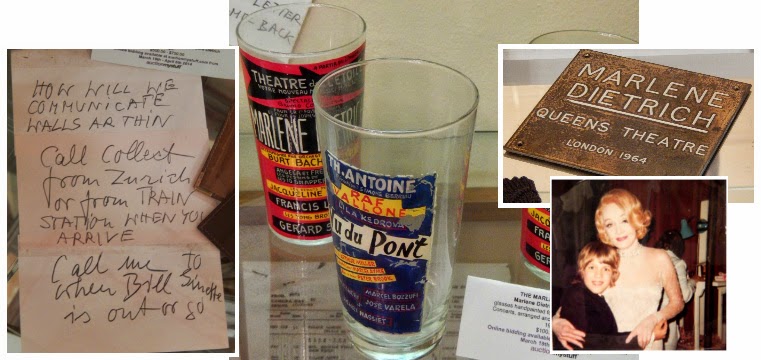“
Actresses Come! Actresses Go! Nothing Ever Happens!” may be an apt tagline for
Marlene Dietrich's unfinished 1936 film,
I Loved a Soldier. The production, a story about a servant girl who falls in love with a soldier at the grand Hotel Imperial, had leading ladies checking in and out at a dizzying rate.
Paramount announced in September 1935 that they had secured the services of Walter Wanger's import, Charles Boyer, to co-star with Dietrich in Invitation to Happiness (a remake of the Pola Negri silent film, Hotel Imperial). Principal photography would commence after Dietrich had completed Desire, which was then just about to go into production.
 |
| At work on "I Loved a Soldier". |
Filming started in early January 1936, on what wags would soon be calling
Paramount's “jinx” picture. Early on there was an accident with a gun, injuring one of the crew members. The bullet barely missed Boyer, singeing his toupée, which must have unnerved the French star.
What unnerved Dietrich was the screenplay (there wasn't a completed draft). Writers, headed by John van Druten and supervised by Ernst Lubitsch, didn't make much progress on that front, but the front office kept themselves busy by re-titling. On the same day Invitation to Happiness became I Loved A Soldier – Mae West's latest belle, Lou, changed her name to Klondike Annie. The casting office, meanwhile, had drafted Paul Lukas for a “major role” and recalled Marlene's Scarlet Empress cohort, Sam Jaffe from New York, as filming continued in a stop-start fashion on the lot.
Director Henry Hathaway would in later years jokingly tell how he had envisioned that Marlene's character – “a slob” – would gradually become more beautiful as her romance with Boyer blossoms:
“You're not supposed to be be beautiful until next Thursday,” Hathaway supposedly warned Dietrich, who pleaded, “can't it at least be Wednesday?”
As battles continued on several fronts, Dietrich wished she “could be like the Americans and get really mad” when she was angry. “The repression of feeling” – a result of her European upbringing, she said, was “very bad for the nerves.” Things came to a head in February when Paramount executives, looking at the shambles around them (not all of it only connected to this film: the company was in serious financial difficulty) and tallying up the almost one million dollars already spent on the Dietrich vehicle, fired Lubitsch.
“When people refuse me something or annoy me, I do not rant, rave and make a scene. I freeze,” Dietrich confided: “I walk out of the production or the room,” which she did, quitting Paramount early in March.
 |
Stock shots like these are likely all that nowadays
survive of the Dietrich-Boyer vehicle, "I Loved a Soldier". |
(Marlene wouldn't be unemployed for long: she had already agreed to do
A Knight Without Armour for
Alexander Korda in London later that year.)
About three chummy days after her walkout, Paramount and Marlene announced they were again “amicable and friendly”. Paramount agreed to recast
I Loved a Soldier without Dietrich, who would make another film for them on her return from London.
 |
| Dietrich (left) and her replacement, Margaret Sullavan (right). |
Margaret Sullavan was obtained from Universal by mid-March as Dietrich's replacement (in exchange for Carole Lombard's services for My Man Godfrey) but the “jinx” struck again when Sullavan broke her arm as she tripped over a wire on the set, after only a few days on the job. A battle-weary Paramount finally shelved the picture when their next replacement choice, Merle Oberon, was unavailable due to a “prior engagement” – The Garden of Allah.
 |
| Dietrich and Boyer, reunited at Selznick. |
Producer David O. Selznick, however, on receiving the news that Dietrich and Boyer had checked out of the “Imperial”, promptly evicted Oberon (and co-star Gilbert Roland) from his Sahara with vague promises to Merle about Dark Victory (Bette Davis would eventually emerge victorious there). By this time Paramount had seemingly lost interest in poor Merle, too.
Dietrich negotiated, called Korda in London (to delay A Knight Without Armour for a couple of weeks) and, on 26 March 1936, signed a $ 200 000 deal with Selznick International: she (and Boyer, and his toupée) agreed to (de)camp to a Technicolor Garden of Allah.
Paramount did get Hotel Imperial on screens in 1939 – in a production starring the Italian Dietrich, Isa Miranda, but even then the old “jinx” re-emerged during filming, when Ray Milland was hospitalised after falling off a horse.
.jpg) A Capricorn, she was one of the first stars to use the services of astrologer Carroll Righter, who had come to Hollywood in 1938. ("The stars impel, they don't compel. What you make of your life depends on you," he said).
A Capricorn, she was one of the first stars to use the services of astrologer Carroll Righter, who had come to Hollywood in 1938. ("The stars impel, they don't compel. What you make of your life depends on you," he said).

.jpg)


















.jpg)
























+(lastgoddess.blogspot.com)+2.jpg)
.jpg)
.jpg)